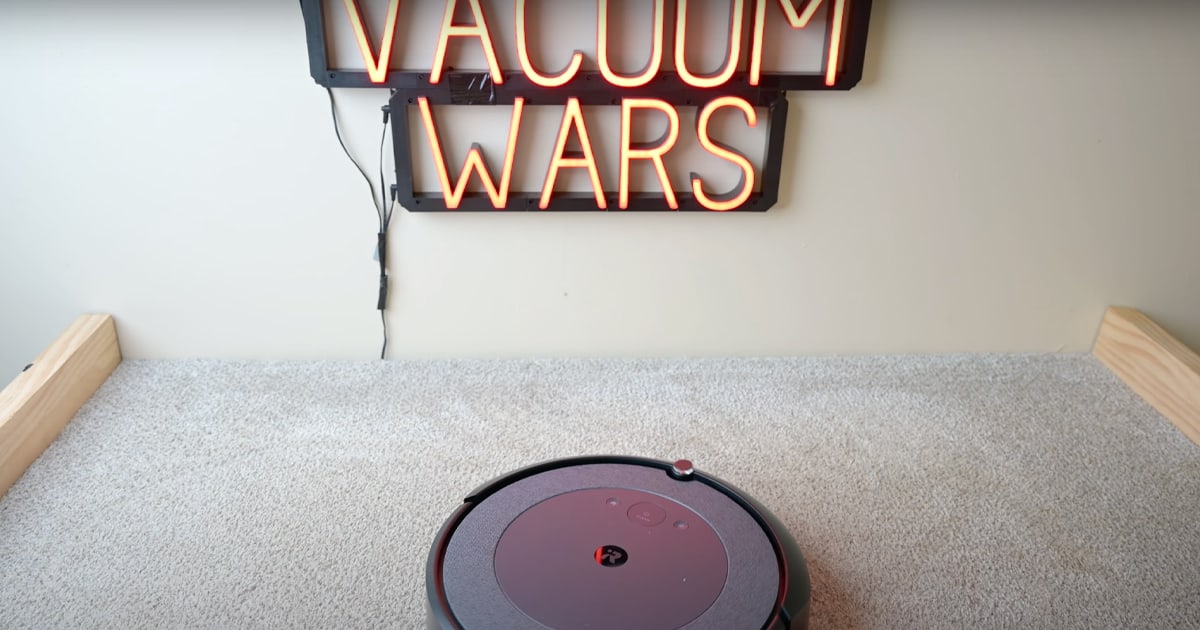In this comparison, we put two popular robot vacuums to various evaluations: the iRobot Roomba i3+ EVO and the Shark AI Ultra. These two robot vacuums are in a similar price range and have similar features, making them a no-brainer for a head-to-head competition.
We put them both through a lot of evaluations over the course of several weeks, and in this article, we’ll compare the results and see which one came out on top.
About the iRobot Roomba i3+ EVO
The Roomba i3+, now called the i3+ EVO, was released after the Roomba i7+. As far as the i-series goes, the most common matchup is the Roomba i3 and i7. The Roomba j7+ and Combo j7+ followed the i3 and i7 models.
Notable and unique features of the Roomba i3+ EVO:
- Dual brushroll design
- Available with auto-empty bin
- Thoroughly cleans when it detects dirt
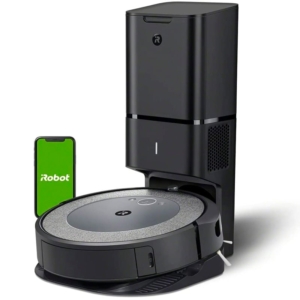
When shopping, you may see the Roomba i3+ and the i3+ EVO, which could cause some confusion. All you need to know is that the i3+ and i3+ EVO are the same robot vacuum with the same features. The original i3 received a software upgrade making it an EVO.
About the Shark AI Ultra Robot
Shark is likely best known for their cordless and upright vacuums. However, they also manufacture and sell very good robot vacuums. The Shark we are specifically evaluating for this comparison is the Shark AV2501S.
Notable and unique features of the Shark AI Ultra:
- LiDAR navigation
- Dual side brushes
- Efficient battery
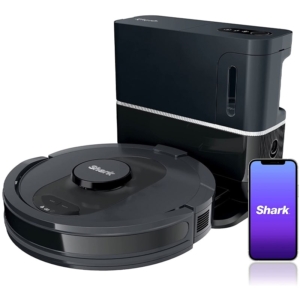
The Shark AI Ultra robot is also sold as the AV2501AE, AV2511AE, and RV2502AE. The differences between those model numbers are the size of the auto-empty bin, what replacement parts are included, and some cosmetic differences.
Features
These two robot vacuums are in a similar price range, so it’s no surprise that they have many of the same features. For example, they both have smart navigation, meaning that they make a map of your house and systematically clean row by row.
How each robot approaches mapping and navigation is a bit different. The Roomba uses floor tracking to create a map and navigate, while the Shark uses a spinning laser called LiDAR.
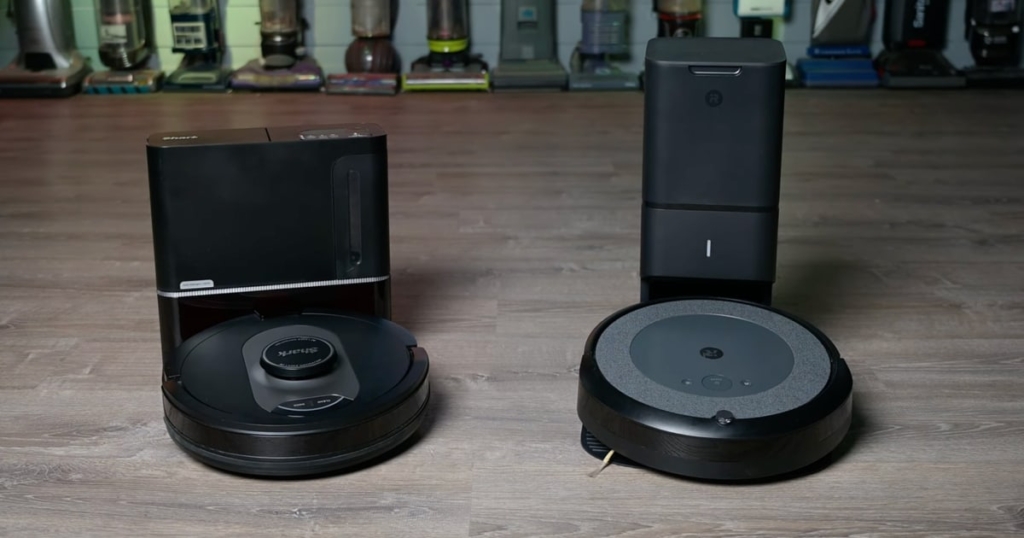
Auto-Empty Bins
If you haven’t seen an auto-empty dustbin, it’s worth looking into. Basically, when the robot finishes its cleaning job and returns to charge its battery, a motor in the base sucks the debris out of the robot’s dustbin and into an included disposable bag.
Auto-empty bins make a big difference as far as convenience goes and we think they’re one of the best features that robot vacuums can have.
Top Robot Vacuums
When it came to picking up surface debris on both hard floors and carpets, arguably the main job of a robot vacuum, both of these robots were incredibly good.
Map Customization and Apps
The Roomba i3+ EVO and Shark AI Ultra both have an app with various smart features. For example, you can create no-go zones with both, which are virtual barriers to keep the robot out of places you don’t want it to go.
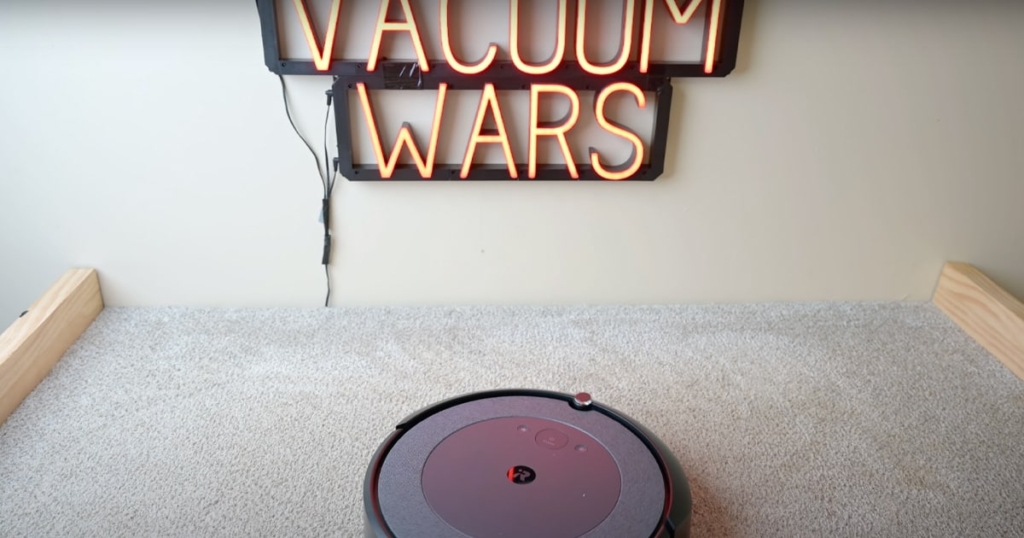
One app feature that the Roomba has but the Shark doesn’t is zone cleaning. Zone cleaning allows you to draw a specific area on the map in the iRobot App. Then, the i3 will go clean just that specific area, returning to the base when it is done. The i3 also has multi-floor mapping, allowing you to make maps for multiple floors in your house. Shark’s AI Ultra Robot can only store a single map.
Cleaning Aids
Another feature that only the Roomba i3+ has is called Dirt Detect. When the robot senses areas that are particularly dirty, Dirt Detect instructs the robot to clean that area more thoroughly. Something else that is unique to the Roomba is its patented dual brush roll design, which we’ll look at later.
One of the only features that the Shark has that the Roomba doesn’t is that it has two side brushes to help with pickup rather than just one. However, both of these robot vacuums have various helpful features. The Roomba i3+ scored higher than the Shark AI Ultra at 87 to 75 for this round.
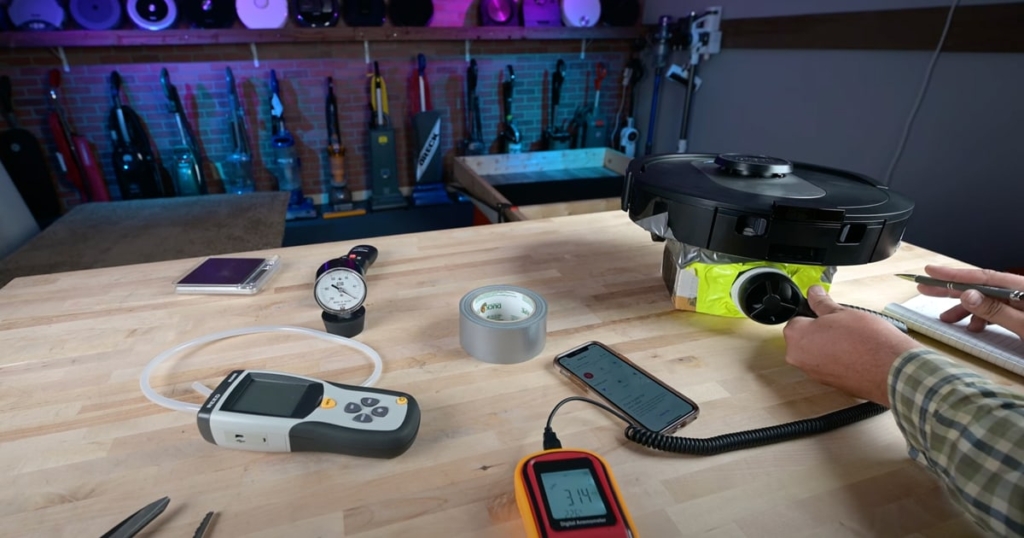
Performance Evaluations
In the performance category, we take into account the results of the bench assessments we perform in the Vacuum Wars studio. Things we measure include airflow, suction, and the results of various debris pickup evaluations.
Debris Pickup on Carpet and Hard Floors
When it came to picking up surface debris on both hard floors and carpets, arguably the main job of a robot vacuum, both of these robots were incredibly good. Both the Roomba and Shark robot picked up everything from fine to extra large debris on both surface types with no noticeable difference between them. In these evaluations, we use various types and sizes of debris, including kitty litter, sand, and cereal of various sizes.
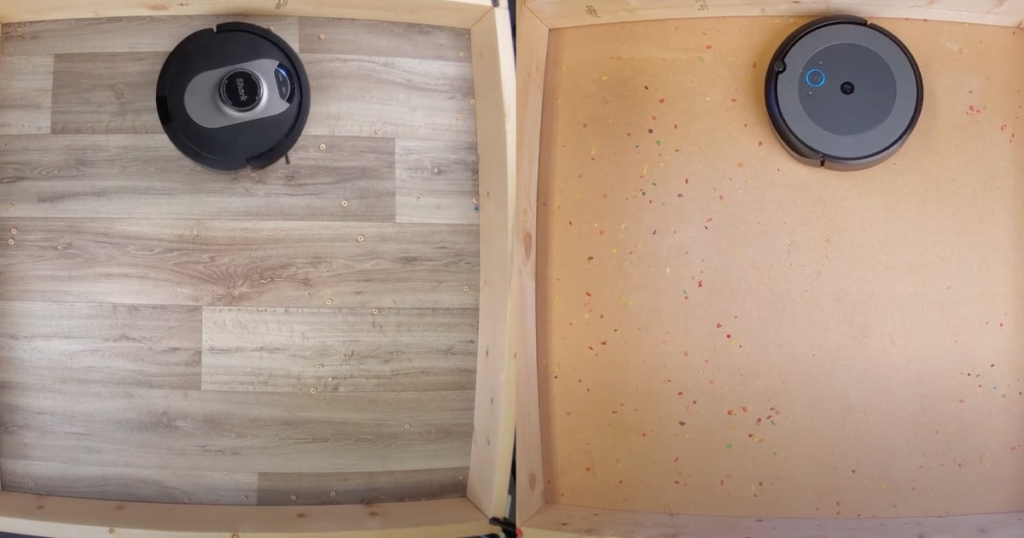
Suction and Airflow
We found the Shark had more raw power when it came to both suction and airflow. This was also evident in our crevice pickup assessment, where it scored higher than the Roomba. To the Roomba’s credit, it did a bit better than the Shark on carpet-related evaluations, including our carpet deep clean assessment. Still, both vacuums scored above average.
After adding up the totals for the performance category, the Shark AI Ultra scored higher than the Roomba i3+ overall.
Navigation Evaluations
We’ve recently updated our navigation evaluations to make them much more comprehensive. Today, we give each vacuum several assessment runs and have them clean a standardized floor plan in different modes and with different power settings where applicable.
Mapping and Navigation
One of the first scores we give is for how quickly each robot vacuum can make a map of a standardized floor plan. The Roomba (with its floor-tracking navigation) was able to create a map more quickly than the Shark (LiDAR navigation).
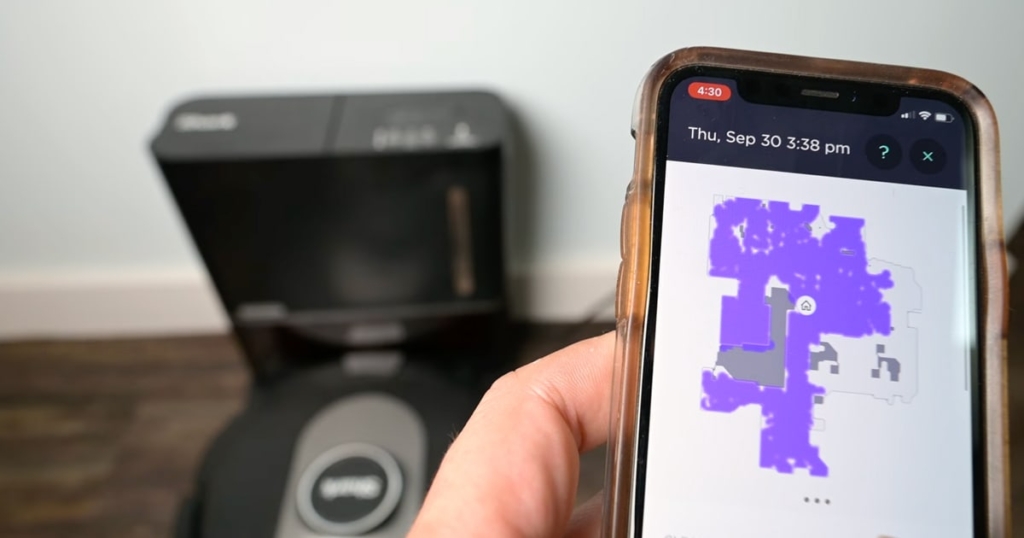
In the navigation assessment, however, we found the Shark AI Ultra to be more efficient than the Roomba, but only by a small amount. The Shark was able to cover 6.8 square feet per minute compared to the Roomba, which scored 5.8 square feet per minute.
But it’s not just about speed. We also take into account their coverage, and the Shark covered more area per run than the Roomba. Essentially, this means the Shark was more precise when vacuuming in and around tight spaces. So, the Shark was more efficient and had higher coverage than the Roomba, which is pretty impressive.
Battery Efficiency
The battery efficiency evaluation helps us get an idea of how good each robot’s battery life is. We evaluate this by taking average measurements of how much each robot’s battery depletes per square meter.
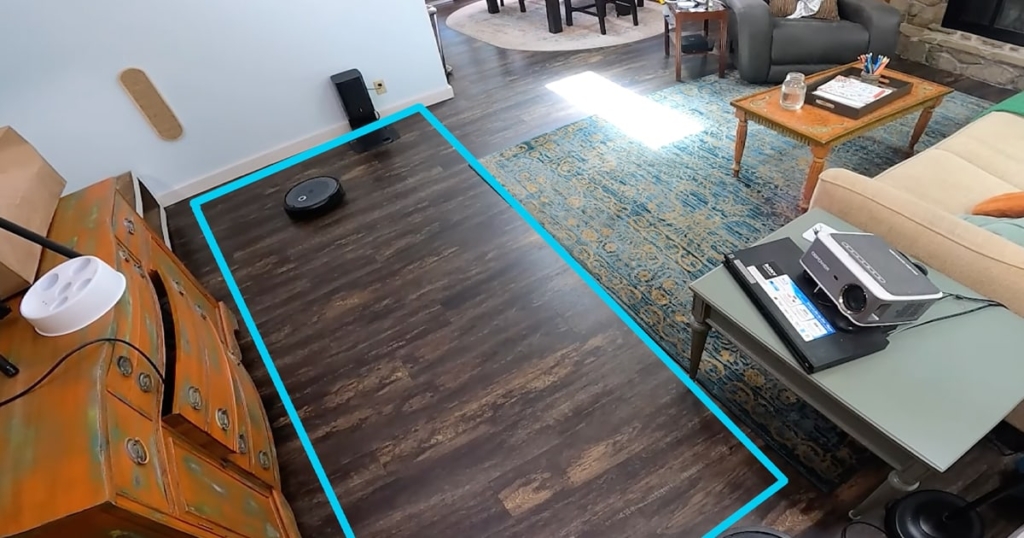
We found that the Shark AI Ultra had better battery efficiency as it was able to cover around 1.5 square meters per charge compared to the Roomba i3 at 1.4 square meters per charge. Running a few calculations based on that data reveals the Shark is capable of covering around 1,019 square feet per battery charge compared to about 820 square feet for the Roomba.
But do take these numbers with a grain of salt, as there are a lot of variables that can alter battery performance, such as flooring type and the complexity of your home. Though the navigation score totals were very close, the Shark did better here.
Roomba i3+ EVO vs Shark AI Ultra Robot: Verdict
After adding up all the scores and adjusting them to a 100-point scale, we narrowly missed a tie, with the Shark AI Ultra just barely beating the Roomba i3+ EVO 78.3 to 78.0.
iRobot Roomba i3+ EVO

Shark AI Ultra

Which should you buy?
If you have over 50% carpet in your home, the Roomba i3+ EVO would be a better choice because of its superior carpet performance. Also, the Shark’s app was not as user-friendly as the Roomba’s. It’s not something that showed up in the scores, but it is certainly something that has been noted in other reviews as well.
On the other hand, the Shark AI Ultra was more accurate with navigation, more efficient, and delivered more power as well as better battery life. Both of these options are high-performing robot vacuums that would be a great addition to any home.
iRobot Roomba i3+ EVO vs Shark AI Ultra Specs
| iRobot Roomba i3+ EVO | Shark AI Ultra Robot | |
| Model | 3550 | AV2501S |
| Auto-Empty | Yes, Included | Yes, Included |
| Navigation | Floor Tracker | LiDAR |
| Map Storage | Multiple | Single |
| Room Cleaning | Yes | Yes |
| Zone Cleaning | Yes | No |
| No-Go Zones/Virtual Walls | Yes | Yes |
| Max Cleaning Time | 75 min | 120 min |
| Battery Charge Time | 3 hours | 6 hours |
| Dual Brushroll | Yes | No |
| Amazon Alexa | Yes | Yes |
| Google Assistant | Yes | Yes |
| Voice Control | Yes | Yes |
| Colors | Grey | Black |
| Buy | Amazon | Amazon |
